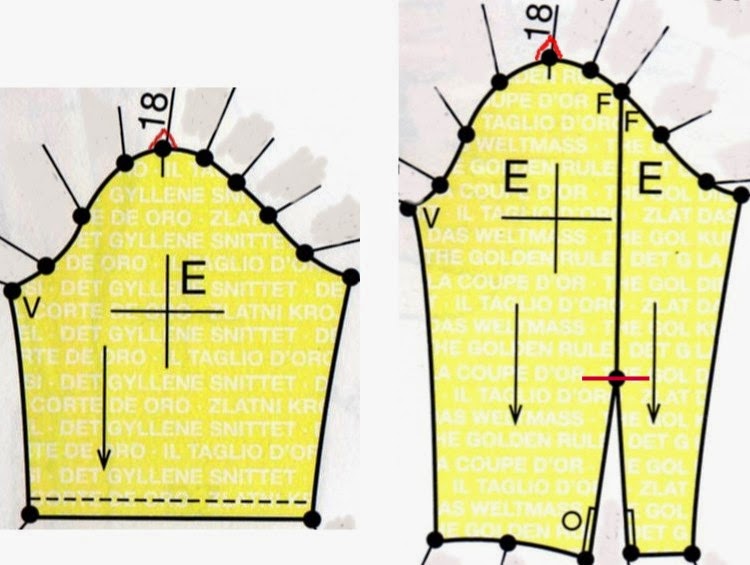Childrens' Collection #2/ Model # 9 - 2013
Girls T -Shirt
FYI: This pattern also appears as the last model in Supplement #284 from 2012.
This T-Shirt is for my ten year old niece, I'll call her K. As you can see, the pattern is suggested for 4-8 year olds but my K is very thin and petite so I can usually get away with a slightly younger pattern. I did notice though, as this top languished away on my sewing table, that K has all of a sudden sprouted tiny boobs. I may need to start using the teen patterns and just scale down. Up until now I have had great success with using a pattern for younger girls and adding several inches to the length.
Pattern Drafting Hints:
The back view for this pattern indicates a center back seam with a keyhole opening.
Since I know K was not going to fuss with a button closure on a T-Shirt I drew the pattern with a fold at the center back and no opening. I'll discuss how I made this work later.
Fabric Used/Suggested:
The body of the T-Shirt is a poly/cotton interlock and the sleeves are a remnant of cotton /lycra left over from a summer skirt. I would suggest a fabric with at least some crosswise stretch for this top just for comfort and wearability for a child.
Design Changes:
As mentioned above I eliminated the center back seam and closure at the neck on this top. Because of this change I also had to abandon the facings since the understitching required to keep them inside also negated any stretch left in the neck hole. I initially attached the facings to the neck but soon realized K's head would never fit through that hole without the opening in back.
I'll admit this T-Shirt did spend a short while in the waste basket until I suddenly thought of a solution. I ended up cutting off the facings and used a satin edge elastic instead. Since the front of this top is gathered I still needed to use the facing patterns to determine the length for the elastic.
I turned my tape measure on edge to measure the edge of the facings that should attach to the neck edge. I cut the elastic at a 1:1 ratio, according to the facings, to fit the neck and then marked the center front, center back and the points at which the front should gather. The elastic was sewn at the 1:1 ratio all around the back neck and when I got to the gathered area I just stretched the elastic to fit the gathers.
The elastic did need a tiny zig zag top stitch to keep it from flipping to the outside. Although the look is not the same as the original fashion drawing I'm still pleased with the outcome. I know K will appreciate the ease of wearing that the elastic neck provides.
Closing Tips:
You may remember the tip I used from my last post on hemming my knit dress with fusible knit interfacing. See the tip at the end of this post.
Well, I couldn't afford to lose any length on this top so I opted for fusible thread instead.
I used fusible thread in the lower looper of my serger to create a similar fusible hem on the inside of this T-Shirt. When the hem is pressed up, right at the edge of the overlock stitches, the hem is neatly fused to the underside and I just finished with the same tiny zig zag top stitch that was used at the neck. I have found this to be a great alternative to a narrow coverstitch when the fabric refuses to stay pressed.
If you have any questions or comments about our reviews please post them to the comments section below. We'd love to help you get the most out of your Lutterloh patterns too!
Happy Sewing and Happy Holidays from Ann and Fonnell!










